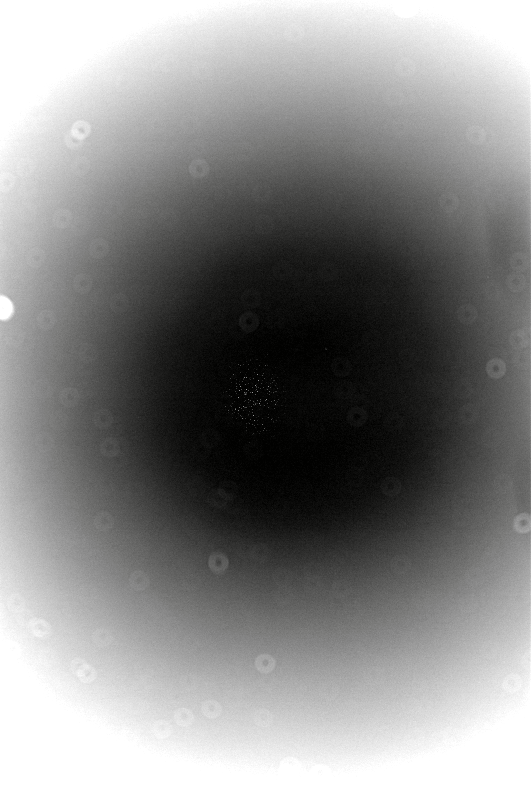
On the night of Aug 13/14, 2022, under good (though bright) conditions, I ran additional tests using an autoguider at the focus on a small telescope mounted piggyback on the 14-inch Celestron in the roll-off structure. I improved the performance of this system, and also started training the mount's Periodic Error Correction (PEC).
I also tried taking wide-field images of the sky to detect Perseid meteors. Alas, the nearly full Moon brightened the sky so much that only a few meteors appear in the pictures (to which there is a link below).
Here's the setup:
I didn't try to take sky flats until long after sunset, so even a 10-second exposure yielded a very low level of counts: 7000 down to 4200 over the sequence of 10 images. When I created the median sky flatfield image, in the usual manner, I noticed that there was a small region near the center of the field which showed a speckled texture. You can see those lower-than-surrounding pixel values as white dots in the picture below.

Those defects do NOT appear later in the night, in target images. I'm not sure what was going on -- possibly ice crystals, but I have no proof. I'll keep an eye on this for the future. I used this flatfield, despite the defects, to reduce tonight's images.
I started by calibrating the autoguider and taking a new set of dark frames; this will be necessary at the start of each night (as long as I remove the camera from the telescope at the end of each night's session and re-attach at the start of the next).

Now, here's what I did for the autoguiding tests:

Here's the guider's view of the field of M57, using an exposure time of 3.5 seconds. One can see M57 faintly near the center, surrounded by stars of mag V=11 (easily visible) and V=12-13 (very faintly visible). The guide star, highlighted by the green crosshairs at upper-right, has a magnitude V=8.

Let's look at the drift in the positions of the stars during these two sets of images.

Clearly, the suggestions improved the quality of the guiding. Hooray!
We can also measure the size and shape of the stellar PSF in each image. Let's look at the two sets ("A" = before and "B" = after adopting guiding suggestions) in this manner:

Adopting the suggestions has improved the PSF. Good.
Next, I tried training the mount's PEC by moving to a field near the celestial equator (near Almizan II) and running the "PEC training" mode while PhD2 was guiding on a star. Before training the PEC, the PhD2 guiding log showed a sinusoidal excursion in RA of about +/- 4 arcsec and period around 500 seconds. After training, the amplitude of the excursion was just 1-2 arcsec, so it seems to have helped.
After this training, I moved to the field of the diffuse nebula NGC 6820 and the open cluster 6823. I took 5 sets of images:
I noticed that the PSF was rather unruly, so I paused to re-focus at this point. I set the binning from 4x4 to 2x2 for the focusing procedure, and cut the width of the PSF in half. I'll try to remember to change the binning for focusing in the future. After focusing, I returned to 4x4 binning.
Once again, we can examine the drift of stars within each set of images.

Somewhat unexpectedly, sets "B" and "C" show a large amount of periodic error in the RA motion. There were two (or three?) occasions during the night when the handpaddle froze, and I had to cycle the power to the mount to restart it . I wonder of one of them occured here, and the "PEC enable/disable" option may have switched back to "disabled". Hmmmm.
The good news is that the drift is very small in Dec over roughly a half-hour, and not too large (2 pixels) in RA.
We can look again at the shape and size of the PSF in these five sets of post-training images.

Hmmm. The FWHM increases slightly in the 30-second guiding images, which doesn't make much sense. The fact that the FWHM increases substantially in the 300-second images is understandable, but also slightly disappointing. At least the FWHM is smaller than it was before refocusing.
Tonight was one day after the peak of the Perseid shower for 2022. I decided to try to capture some of them, even though the nearly full Moon would make the sky very bright. I arranged this equipment on the concrete pad and let it run for 4-5 hours as I wrestled with the 14-inch.
A representative photo -- no, it's the one which shows the most interesting feature -- was taken at EDT Aug 13 22:07:50. (click to see the full-size version). North is at the bottom of the screen, East to the right.
This was probably a plane, not a fireball, but it sure is pretty.
I created movies by simply concatenating all the images together. Well, maybe not so simply. For future reference, here's a script with all the commands.
The movies are rather large, I'm afraid, even after I shrank every image to 50% of its original size. If one watches closely, one can see four or five faint streaks which are likely to be Perseids.
The PhD2 program produces logs recording many properties of the communications between mount and camera during the night. I've saved those logs and place them here: